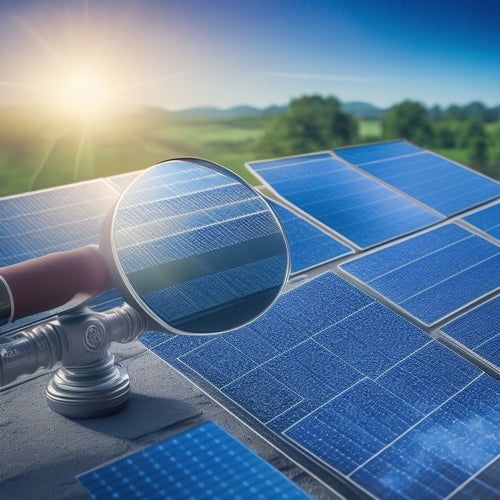
7 Best Ways to Monitor Your Home's Energy Output
Share
You can optimize your energy usage and reduce your carbon footprint by monitoring your home's energy output in several ways. Track your energy production to understand your goals and adjust your habits. Utilize real-time monitoring systems to optimize your energy output. Energy output analytics tools provide personalized recommendations to reduce your carbon footprint. Smart inverters offer granular insights and predictive forecasting. Mobile apps and web-based platforms enable real-time monitoring, data organization, and alerts. Advanced data logging systems provide accurate tracking and scalability. By exploring these methods, you'll gain a deeper understanding of your energy usage and uncover opportunities to maximize your energy output efficiently.
Key Takeaways
• Utilize real-time monitoring systems to track energy production and consumption, identifying areas for improvement and optimizing output.
• Leverage mobile apps and web-based platforms to access energy data, receive alerts, and customize dashboards for convenience.
• Integrate energy monitoring systems with smart devices and existing infrastructure for seamless connectivity and optimized performance.
• Implement data analytics to gain instant insights into energy usage patterns, detect anomalies, and make informed decisions for efficiency.
• Conduct regular maintenance and utilize smart inverters for proactive alerts to ensure peak system performance and energy savings.
Tracking Your Energy Production
How much electricity are you generating from your solar panels or wind turbines, and is it sufficient to power your home? Tracking your energy production is essential to understanding your energy goals and adjusting your habits accordingly.
You've invested in renewable energy, now it's time to reap the benefits.
Start by setting realistic energy goals, such as powering your entire home or reducing your reliance on the grid. Next, create a production schedule to optimize your energy output. This could mean adjusting the angle of your solar panels or scheduling maintenance for your wind turbines.
By monitoring your energy production, you can identify areas for improvement and make data-driven decisions. Are your solar panels underperforming due to shade or debris? Do your wind turbines need a tune-up to maximize output? With accurate tracking, you'll be able to pinpoint issues and take corrective action.
Real-Time Monitoring Systems
When it comes to real-time monitoring systems, you'll want to explore the various options for tracking your energy usage. Integrating these systems with your existing infrastructure is crucial. Leveraging real-time data analytics to optimize your energy output is also essential. By doing so, you'll gain a better understanding of your energy production and consumption patterns. This will enable you to make data-driven decisions.
In the following sections, we'll examine each of these aspects in more detail, providing you with the insights you need to maximize your home's energy efficiency.
Energy Usage Tracking
Real-time monitoring systems play a vital role in allowing you to track your home's energy usage in real-time, providing instant insights into your energy consumption patterns. With this technology, you can identify areas of inefficiency and make adjustments to optimize your energy usage. This is essential for achieving energy efficiency, which not only helps the environment but also leads to significant cost savings.
By monitoring your energy usage in real-time, you can pinpoint appliances or systems that are guzzling energy. For instance, you might discover that your old refrigerator is consuming more power than you thought. With this knowledge, you can consider replacing it with an energy-efficient model, which can lead to substantial cost savings over time.
Real-time monitoring systems provide a granular view of your energy consumption, enabling you to make data-driven decisions to reduce your energy bills. By tracking your energy usage in real-time, you can identify opportunities to optimize your energy consumption, leading to a more sustainable and cost-effective lifestyle.
System Integration Options
You have several system integration options to explore when selecting a real-time monitoring system, each with its unique features and compatibility requirements.
When it comes to integrating your energy monitoring system, you'll need to think about how it will communicate with other devices and systems in your home. Cloud connectivity is an important option, allowing you to access your energy usage data from anywhere, at any time. This is especially valuable if you're away from home and want to keep an eye on your energy consumption.
Another vital aspect to take into account is the network protocols used by your monitoring system. Will it communicate via Wi-Fi, Zigbee, or Z-Wave? Make sure the protocols are compatible with your existing smart home devices to guarantee seamless integration.
Some systems may also offer integration with popular voice assistants, like Alexa or Google Assistant, allowing you to access your energy data with voice commands.
Real-Time Data Analytics
With real-time data analytics, your monitoring system provides instant insights into your home's energy usage patterns, empowering you to pinpoint areas of inefficiency and take corrective action promptly. You'll be able to identify which appliances are guzzling the most energy and when, allowing you to make adjustments to reduce your consumption.
This isn't just about saving energy; it's about saving cash too.
Machine learning algorithms and predictive modeling enable your system to detect anomalies and alert you to potential issues before they become major problems. Imagine receiving notifications when your energy usage spikes, allowing you to investigate and address the issue before it breaks the bank.
With real-time data analytics, you'll be able to optimize your energy usage, reduce waste, and make informed decisions about your home's energy output. By leveraging the power of data, you'll be well on your way to becoming an energy-efficient mastermind.
Energy Output Analytics Tools
As you explore energy output analytics tools, you'll discover that energy monitoring platforms can provide valuable insights into your home's energy consumption patterns.
These platforms typically offer real-time energy tracking, enabling you to identify areas of inefficiency and optimize your energy usage.
Energy Monitoring Platforms
Energy monitoring platforms, such as smart plugs and whole-home energy monitors, provide real-time insights into your home's energy output, empowering you to discover areas of inefficiency and optimize your energy usage.
These platforms are the key to accessing Energy Security and Sustainable Living in your home. By monitoring your energy output, you'll be able to pinpoint which appliances and devices are consuming the most energy, and take action to reduce your carbon footprint.
Imagine being able to see exactly how much energy your beloved coffee maker is using, and making the switch to a more energy-efficient model. With energy monitoring platforms, you'll have the ability to make informed decisions about your energy usage, and take control of your energy bills.
Plus, many of these platforms offer personalized recommendations for reducing energy waste, making it easy to make a positive impact on the environment. By embracing energy monitoring platforms, you'll be well on your way to a more sustainable, energy-efficient lifestyle.
Real-time Energy Tracking
You can gain a deeper understanding of your home's energy output by leveraging real-time energy tracking tools, which provide instantaneous data on your energy consumption patterns. These tools empower you to make informed decisions about your energy usage, helping you reduce your carbon footprint and save on your utility bills.
With real-time energy tracking, you can:
-
Identify energy-hungry appliances and replace them with more efficient alternatives
-
Optimize your energy usage to minimize peak demand charges
-
Receive alerts when unusual energy patterns are detected
-
Analyze your energy usage to identify opportunities for energy efficiency improvements
-
Contribute to a more resilient grid through energy forecasting and grid resiliency efforts
Smart Inverters for Insights
Smart inverters, integrated into your solar panel system, track and analyze your home's energy production in real-time, providing granular insights into your energy output. This means you'll have a precise understanding of how much energy your solar panels are generating, and when. With this data, you can identify areas for improvement, making adjustments to optimize your energy production.
Regular inverter maintenance is important to guarantee your system operates at peak performance. Smart inverters make it easy by providing alerts and notifications when maintenance is required. This proactive approach helps prevent unexpected downtime, saving you time and money.
Smart inverters also enable energy forecasting, allowing you to predict your energy production based on historical data and weather patterns. This feature helps you plan your energy usage, reducing your reliance on the grid and maximizing your solar energy savings.
Mobile Apps for Energy Tracking
With mobile apps, your smartphone becomes a command center for tracking your home's energy output, providing instant access to real-time data and analytics on your energy production. This means you can monitor your energy usage on-the-go, receiving alerts and notifications when something's amiss.
Many apps offer customization options, allowing you to tailor the user experience to your needs. You can set up personalized dashboards, receive customized notifications, and even integrate with other smart home devices.
Here are some key features to look for in a mobile app for energy tracking:
-
Real-time monitoring: Get instant updates on your energy production and consumption
-
Customizable dashboards: Organize your data in a way that makes sense to you
-
Push notifications: Receive alerts when energy usage spikes or dips
-
Integration with smart devices: Connect your energy monitoring app with other smart home devices for a seamless experience
-
Data analytics: Dive deeper into your energy usage patterns to identify areas for improvement
Web-Based Monitoring Platforms
Web-based monitoring platforms allow homeowners to access their energy data from any device with an internet connection, providing a flexible and convenient way to track energy production and consumption. This means you can check your energy usage from your couch, office, or even on-the-go.
These platforms typically store your data in the cloud, ensuring it's secure and backed up, thanks to robust Cloud Security measures.
When choosing a web-based monitoring platform, consider the User Experience. Look for an intuitive interface that makes it easy to navigate and understand your energy data. You should be able to view real-time data, track your energy consumption over time, and set customizable alerts for unusual energy spikes. Some platforms also offer personalized recommendations to help you optimize your energy usage.
With a web-based monitoring platform, you'll have a clearer picture of your energy output, empowering you to make informed decisions about your energy usage. By leveraging these platforms, you'll be well on your way to reducing your energy bills and minimizing your carbon footprint.
Advanced Data Logging Systems
You can take your energy monitoring to the next level with advanced data logging systems, which provide a more detailed and granular view of your energy output by tracking and recording data at shorter intervals. These systems are perfect for homeowners who want to get down to the nitty-gritty of their energy usage. With advanced data logging, you can identify areas of inefficiency and make data-driven decisions to optimize your energy consumption.
Here are some benefits of advanced data logging systems:
-
Higher Data Quality: Advanced data logging systems can track energy usage in real-time, providing a more accurate picture of your energy output.
-
System Scalability: These systems can handle large amounts of data, making them perfect for larger homes or commercial buildings.
-
Increased Granularity: Advanced data logging systems can track energy usage at the circuit level, giving you a detailed view of which appliances are using the most energy.
-
Customizable Alerts: Set up custom alerts to notify you when energy usage spikes or when there's an issue with your system.
-
Compliance with Energy Standards: Advanced data logging systems can help you comply with energy efficiency standards and regulations.
Frequently Asked Questions
Can I Monitor My Home's Energy Output Remotely?
You can totally monitor your home's energy output remotely using smart plugs that track energy consumption in real-time, giving you a bird's eye view of your energy usage, and helping you identify areas for improvement.
How Often Should I Upgrade My Energy Monitoring System?
You should upgrade your energy monitoring system every 5-7 years, considering the system's lifespan, as technology advances rapidly, ensuring data accuracy and avoiding outdated features that might mislead your energy-saving efforts.
Are Energy Monitoring Systems Compatible With All Inverters?
Checking compatibility is crucial when dealing with energy monitoring systems and various inverter types. System limitations may arise with older or proprietary inverters, so make sure to verify compatibility before making a purchase, okay?
Can Energy Monitoring Systems Detect Potential Electrical Issues?
You'll be relieved to know that advanced energy monitoring systems can detect potential electrical issues through fault detection and circuit analysis, helping you identify problems before they become major headaches.
Do Energy Monitoring Systems Require Professional Installation?
You're wondering if you can DIY install an energy monitoring system or need a pro? It depends on system complexity and your tech skills; consider installation costs, technician qualifications, and warranty requirements before deciding.
Related Posts
-

Why Go Green With Automotive Products Online?
By switching to eco-friendly automotive products online, you're taking a significant step towards reducing your carbo...
-

Solar Panel System Certification Costs: A 10-Point Breakdown
You're looking to understand the costs associated with solar panel system certification. Your total certification cos...
-

5 Ways Bike Sharing Boosts Urban Sustainability
As you explore bike-sharing options, you'll discover five ways it boosts urban sustainability. By reducing congestion...


